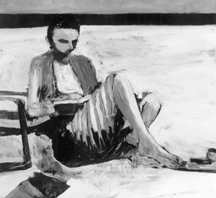

[ Metro | Metroactive Central | Archives ]
Bay Area Art Beats
California art at Triton Museum
By Ann Elliott Sherman
When visiting the Triton Museum's exhibition of Bay Area artists' works from the Anderson Collection, two tracks of thought get laid down--the primary groove of seeing the development of individual artists' careers and/or representative works of just about every genre of Bay Area art, and the thought, "One family owns all this and more?" Thank God for the intersection of highly developed aesthetic instincts and tax advantages.
Gallery 1 highlights the paintings of Sam Francis, David Park, Nathan Oliveira and, most prominently, Richard Diebenkorn. It's plain to see that, as the fine catalog essay by Katherine Church Holland notes, whether he was painting a figure or an abstracted landscape, Diebenkorn composed his work in the same way, with definite horizons and horizontal sections of the canvas cut by strong diagonal lines and odd angles--and with the whole view cropped like a photograph.
The implication that there is so much more that can't be fit within one canvas both focuses our attention and gives rise to a feeling of expansiveness. One look at the light-washed colors of Ocean Park #60, and you feel that California truly is a golden state.
An interesting contrast is provided by Oliveira's obsession with engulfing darkness. The Face of a Woman blooms like a white stamen deep in the throat of a black calla lily; Stage #2 With Bed reveals the play of near-blackness upon color. Both are haunting, for their very human presence or the aching suggestion of its passing.
Although an admirer and former practitioner of nonrepresentational abstraction, Park once said that such works often seemed "so visually beautiful that I find them insufficiently troublesome." The paintings he did one year before losing a battle with cancer give one plenty to deal with. With a palette of autumn hues forcefully colliding with the harsh black-and-white starkness of an early winter, Two Heads and Four Women get down to the essence of human form and existence--more alike than different, yet alone even in a crowd.
Gallery 2 covers a lot of ground. With the exception of the large grouping of strong abstract work by Frank Lobdell, it's a smattering of one or two pieces by a wide range of artists. The overall impression is a kind of collegial iconoclasm, with schools like the California School of Fine Arts (now San Francisco Art Institute), California College of Arts and Crafts, UC-Berkeley and UC-Davis functioning like a centrifuge.
Faculty and students would come together, exert a certain amount of reciprocal influence, and then individual artists would spin out in their own direction. (With only two women represented, it's easy to understand the activist feminism of the Guerrilla Girls.) Goofing with words in the manner of the North Beach Beats spilled over into visual puns and sardonic or whimsical narratives seen here in William Allen's Half a Dam, Robert Arneson's Sinking Brick Plates and William T. Wiley's Lame and Blind in Eden.
In the midst of all this self-consciousness, two drawings by Roy De Forest jump out like messages from another world. Paraphrasing his convoluted catalog statement, De Forest sees art functioning as a microcosm condensed through the artist's visionary projection of an inward process to become "a metaphor for the complete and terrible chaos of the total sum of everything." Fittingly, he uses every kind of directly applied material--pastel, felt pen, crayon, pencil--in these images of a reality both flattened and inflated, full of cartoonish dogs, horses and people.
The frames themselves--crude wood embellished with stripes, Xs and daubs of paint--announce that we are encountering a singular perspective. Despite the folkish overtones, De Forest never comes off as feigning naiveté; instead, he opens a pipeline to a consciousness most of us keep buried.
The Andersons have an amazing survey of Bay Area sculpture, as well, from Fletcher Benton's motorized explorations of color and clarity to Sam Richardson's plastic odes to hidden wonders of the natural world. These pieces prove that innovative use of materials and technique is not mutually exclusive from elegance and fun.
But that could be the credo of Bay Area art itself--eclectic and individual, gregarious and introspective, in the spirit of the Barbary Coast. The Anderson Collection has mined many of its riches.
[ Metro | Metroactive Central | Archives ]
This page was designed and created by the Boulevards team.

Girl on the Beach: Oil on canvas by Richard Diebenkorn, 1957
From the Dec. 21-27, 1995 issue of Metro
Copyright © 1995 Metro Publishing and Virtual Valley, Inc.